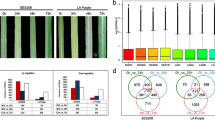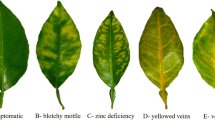Abstract
Sporisorium scitamineum is a teleomorphic, biotrophic fungus causing the globally prevalent sugarcane smut disease in sugarcane. The severity of the disease depends on two major factors, viz. degree of resistance in the host genotype and virulence level of the pathogen. Hence, in this study, temporal transcriptomic expression of potential pathogenicity-associated genes of two distinctly virulent S. scitamineum isolates, viz. SsV89101 (low virulent) and Ss97009 (high virulent) were analyzed during interaction with a smut susceptible sugarcane cv. Co 97009 at six different time intervals. The pathogenicity-associated genes profiled in this study comprises 14 plant cell wall degrading enzymes (PCWDEs) and ten candidates secreted effector protein-coding (CSEPs) genes. Absolute quantification of pathogen biomass and comparative expression profiling analyses of these pathogenicity-associated genes during host–pathogen interaction indicated that there was a significant variation between low and high virulent isolates. More precisely, the higher and early expression (24 hpi) of certain PCWDEs, viz. Chitinase-1 and Laccase, and the CSEPs, viz. SUC2, SRT1 and CMU1 during the colonization of high virulent isolate suggested that they might possibly play a major role in facilitating faster and successful pathogen ingress, and tissue colonization than the less-virulent isolate. Transcript expression profiling of Chitinase and Laccases were also in correlation with their corresponding enzyme activity assays. Comprehensively, this quantitative temporal expression analysis has provided critical insights into the early expression of pathogenicity-associated genes and their putative role in attributing to higher virulence. Moreover, this study provides valuable clues for the screening of candidate virulence determinants for further functional characterization of the test pathogen isolates used for the evaluation of smut resistance in breeding clones.






Similar content being viewed by others
References
Albert HH, Susan S (1996) PCR amplification from a homolog of the bE mating-type gene as a sensitive assay for the presence of U. scitaminea DNA. Plant Dis 80:1189–1192. https://doi.org/10.1094/PD-80-1189
Almakarem AS, Heilman KL, Conger HL et al (2012) Extraction of DNA from plant and fungus tissues in situ. BMC Res Notes. https://doi.org/10.1186/1756-0500-5-266
Barnabas L, Ashwin NMR, Kaverinathan K et al (2016) Proteomic analysis of a compatible interaction between sugarcane and Sporisorium scitamineum. Proteomics 16:1111–1122. https://doi.org/10.1002/pmic.201500245
Barnabas L, Ashwin NMR, Kaverinathan K et al (2017a) In vitro secretomic analysis identifies putative pathogenicity-related proteins of Sporisorium scitamineum – the sugarcane smut fungus. Fungal Biol 121:199–211. https://doi.org/10.1016/j.funbio.2016.11.004
Barnabas L, Ashwin NMR, Ramesh Sundar A et al (2017b) Putative orthologs of Ustilago maydis effectors screened from the genome of sugarcane smut fungus – Sporisorium scitamineum. Australas Plant Pathol 46:147–156. https://doi.org/10.1007/s13313-017-0471-6
Barnabas L, Ashwin NMR, Nalayeni K et al (2018) Genetic and pathogenic variability among the Indian isolates of Sporisorium scitamineum causing sugarcane smut. J Sugarcane Res 8:138–154
Bhuiyan SA, Croft BJ, Cox MC et al (2010) Varietal resistance of sugarcane to natural infection of smut - preliminary results. In: 32nd Annu Conf Aust Soc Sugar Cane Technol 2010, ASSCT 2010, vol 32, pp 355–365
Bhuiyan SA, Croft BJ, Deomano EC et al (2013) Mechanism of resistance in Australian sugarcane parent clones to smut and the effect of hot water treatment. Crop Pasture Sci 64:892–900. https://doi.org/10.1071/CP13286
Bhuiyan SA, Croft BJ, Stringer JK et al (2015) Pathogenic variation in spore populations of Sporisorium scitamineum, causal agent of sugarcane smut in Australia. Plant Dis 99:93–99. https://doi.org/10.1094/PDIS-12-13-1257-RE
Croft BJ, Braithwaite KS (2006) Management of an incursion of sugarcane smut in Australia. Australas Plant Pathol 35:113–122. https://doi.org/10.1071/AP05104
Desentis-Mendoza RM, Hernández-Sánchez H, Moreno A et al (2006) Enzymatic polymerization of phenolic compounds using laccase and tyrosinase from Ustilago maydis. Biomacromol 7:1845–1854. https://doi.org/10.1021/bm060159p
Djamei A, Kahmann R (2012) Ustilago maydis: Dissecting the molecular interface between pathogen and plant. PLoS Pathog 8:e1002955. https://doi.org/10.1371/journal.ppat.1002955
Djamei A, Schipper K, Rabe F et al (2011) Metabolic priming by a secreted fungal effector. Nature 478:395–398. https://doi.org/10.1038/nature10454
Doehlemann G, Van Der Linde K, Abmann D et al (2009) Pep1, a secreted effector protein of Ustilago maydis, is required for successful invasion of plant cells. PLoS Pathog 5:e1000290. https://doi.org/10.1371/journal.ppat.1000290
Doehlemann G, Reissmann S, Abmann D et al (2011) Two linked genes encoding a secreted effector and a membrane protein are essential for Ustilago maydis-induced tumour formation. Mol Microbiol 81:751–766. https://doi.org/10.1111/j.1365-2958.2011.07728.x
Dutheil JY, Mannhaupt G, Schweizer G et al (2016) A tale of genome compartmentalization: The evolution of virulence clusters in smut fungi. Genome Biol Evol 8:681–704. https://doi.org/10.1093/gbe/evw026
Hemetsberger C, Herrberger C, Zechmann B et al (2012) The Ustilago maydis effector Pep1 suppresses plant immunity by inhibition of host peroxidase activity. PLoS Pathog 8:e1002684. https://doi.org/10.1371/journal.ppat.1002684
Horst RJ, Engelsdorf T, Sonnewald U, Voll LM (2008) Infection of maize leaves with Ustilago maydis prevents establishment of C4 photosynthesis. J Plant Physiol 165:19–28. https://doi.org/10.1016/j.jplph.2007.05.008
Kämper J, Kahmann R, Bölker M et al (2006) Insights from the genome of the biotrophic fungal plant pathogen Ustilago maydis. Nature 444:97–101. https://doi.org/10.1038/nature05248
Kumar D, Long SP, Singh V (2018) Biorefinery for combined production of jet fuel and ethanol from lipid-producing sugarcane: a techno-economic evaluation. GCB Bioenergy 10:92–107. https://doi.org/10.1111/gcbb.12478
Lanver D, Müller AN, Happel P et al (2018) The biotrophic development of Ustilago maydis studied by RNA-seq analysis. Plant Cell 30:300–323. https://doi.org/10.1105/tpc.17.00764
Liang L (2012) The role of Stp1, a secreted effector, in the biotrophic interaction of Ustilago maydis and its host plant maize. Dissertation. Philipps University Marburg
Livak KJ, Schmittgen TD (2001) Analysis of relative gene expression data using real-time quantitative PCR and the 2-ΔΔCT method. Methods 25:402–408. https://doi.org/10.1006/meth.2001.1262
Martinez C, Roux C, Jauneau A, Dargent R (2002) The biological cycle of Sporisorium reilianum f. sp. zeae: an overview using microscopy. Mycologia 94:505–514. https://doi.org/10.1080/15572536.2003.11833215
Mueller O, Kahmann R, Aguilar G et al (2008) The secretome of the maize pathogen Ustilago maydis. Fungal Genet Biol 45:36–70. https://doi.org/10.1016/j.fgb.2008.03.012
Mueller AN, Ziemann S, Treitschke S et al (2013) Compatibility in the Ustilago maydis–maize interaction requires inhibition of host cysteine proteases by the fungal effector Pit2. PLoS Pathog 9:e1003177. https://doi.org/10.1371/journal.ppat.1003177
Ngugi K, Nzioki H, Githiri SM (2008) Evaluation of smut inoculation techniques in sugarcane seedlings. Sugar Tech 10:341–345. https://doi.org/10.1007/s12355-008-0060-7
Okmen B, Mathow D, Hof A et al (2018) Mining the effector repertoire of the biotrophic fungal pathogen Ustilago hordei during host and non-host infection. Mol Plant Pathol 19:2603–2622. https://doi.org/10.1111/mpp.12732
Palaniswamy H, Syamaladevi DP, Mohan C et al (2016) Vacuolar targeting of r-proteins in sugarcane leads to higher levels of purifiable commercially equivalent recombinant proteins in cane juice. Plant Biotechnol J 14:791–807. https://doi.org/10.1111/pbi.12430
Que Y, Xu L, Wu Q et al (2014) Genome sequencing of Sporisorium scitamineum provides insights into the pathogenic mechanisms of sugarcane smut. BMC Genomics 15:1–20. https://doi.org/10.1186/1471-2164-15-996
Raboin LM, Selvi A, Oliveira KM et al (2007) Evidence for the dispersal of a unique lineage from Asia to America and Africa in the sugarcane fungal pathogen Ustilago scitaminea. Fungal Genet Biol 44:64–76. https://doi.org/10.1016/j.fgb.2006.07.004
Schaker PDC, Peters LP, Cataldi TR et al (2017) Metabolome dynamics of smutted sugarcane reveals mechanisms involved in disease progression and whip emission. Front Plant Sci 8:882. https://doi.org/10.3389/fpls.2017.00882
Schirawski J, Mannhaupt G, Münch K et al (2010) Pathogenicity determinants in smut fungi revealed by genome comparison. Science 330:1546–1548. https://doi.org/10.1126/science.1195330
Schuster M, Schweizer G, Kahmann R (2018) Comparative analyses of secreted proteins in plant pathogenic smut fungi and related basidiomycetes. Fungal Genet Biol 112:21–30. https://doi.org/10.1016/j.fgb.2016.12.003
Schweizer G, Münch K, Mannhaupt G et al (2018) Positively selected effector genes and their contribution to virulence in the smut fungus Sporisorium reilianum. Genome Biol Evol 10:629–645. https://doi.org/10.1093/gbe/evy023
Solomon S (2016) Sugarcane production and development of sugar industry in India. Sugar Tech 18:588–602. https://doi.org/10.1007/s12355-016-0494-2
Spanu PD, Panstruga R (2017) Biotrophic plant-microbe interactions. Front Plant Sci 8:1–4. https://doi.org/10.3389/fpls.2017.00192
Srinivasan KV (1971) Hot water treatment for disease control. Sugarcane Pathol Newslett 6:46
Su Y, Wang S, Guo J et al (2013) A TaqMan real-time PCR assay for detection and quantification of Sporisorium scitamineum in sugarcane. Sci World J. https://doi.org/10.1155/2013/942682
Su Y, Wang Z, Xu L et al (2016) Early selection for smut resistance in sugarcane using pathogen proliferation and changes in physiological and biochemical indices. Front Plant Sci 7:1133. https://doi.org/10.3389/fpls.2016.01133
Sundar AR, Barnabas E, Malathi P et al (2012) A mini review on smut disease of sugarcane caused by Sporisorium scitamineum. Botany 53:107–128. https://doi.org/10.5772/34116
Sundar AR, Ashwin NMR, Barnabas EL et al (2015) Disease resistance in sugarcane – an overview. Sci Agrar Paranaensis 14(4):200–212. https://doi.org/10.18188/1983-1471/sap.v14n4p200-212
Tanaka S, Brefort T, Neidig N et al (2014) A secreted Ustilago maydis effector promotes virulence by targeting anthocyanin biosynthesis in maize. Elife 3:1–27. https://doi.org/10.7554/eLife.01355
Taniguti LM, Schaker PDC, Benevenuto J et al (2015) Complete genome sequence of Sporisorium scitamineum and biotrophic interaction transcriptome with sugarcane. PLoS ONE 10:e0129318. https://doi.org/10.1371/journal.pone.0129318
Wahl R, Wippel K, Goos S et al (2010) A novel high-affinity sucrose transporter is required for virulence of the plant pathogen Ustilago maydis. PLoS Biol 8:e1000303. https://doi.org/10.1371/journal.pbio.1000303
Wu Q, Xu L, Guo J et al (2013) Transcriptome profile analysis of sugarcane responses to Sporisorium scitaminea infection using solexa sequencing technology. Biomed Res Int. https://doi.org/10.1155/2013/298920
Yan M, Zhu G, Lin S et al (2016) The mating-type locus b of the sugarcane smut Sporisorium scitamineum is essential for mating, filamentous growth and pathogenicity. Fungal Genet Biol 86:1–8. https://doi.org/10.1016/j.fgb.2015.11.005
Zarei M, Aminzadeh S, Zolgharnein H et al (2011) Characterization of a chitinase with antifungal activity from a native Serratia marcescens B4A. Braz J Microbiol 42:1017–1029. https://doi.org/10.1590/S1517-83822011000300022
Acknowledgements
The authors thank the Director, Indian Council of Agricultural Research—Sugarcane Breeding Institute, India for providing facilities and continuous encouragement. Financial support provided by the Department of Biotechnology (DBT), New Delhi (Sanction F.No. BT/PR12883/BPA/118/142/2015) and by the Department of Science and Technology, Ministry of Science and Technology, SERB sanction No. EMR/2016/006055 is greatly acknowledged.
Author information
Authors and Affiliations
Contributions
ARS conceptualized, designed, and supervised the study. KN performed lab experiments and contributed to data analysis and data interpretations. NMRA, ARS and LB interpreted the whole data retrieved from gene expression analysis. KN and NMRA wrote the manuscript. TV and VNA assisted in executing the experiments. ARS, PM and RV shared their expertise in editing and revising the content of the manuscript. All authors read and approved the final manuscript.
Corresponding author
Ethics declarations
Conflict of interest
The authors declare that they have no conflict of interest in the publication.
Research involving human participants and/or animals
The present research did not involve human participants and/or animals.
Informed consent
Informed consent was obtained from all individual participants included in the study.
Supplementary Information
Below is the link to the electronic supplementary material.
Rights and permissions
About this article
Cite this article
Nalayeni, K., Ashwin, N.M.R., Barnabas, L. et al. Comparative expression analysis of potential pathogenicity-associated genes of high- and low-virulent Sporisorium scitamineum isolates during interaction with sugarcane. 3 Biotech 11, 353 (2021). https://doi.org/10.1007/s13205-021-02893-7
Received:
Accepted:
Published:
DOI: https://doi.org/10.1007/s13205-021-02893-7




